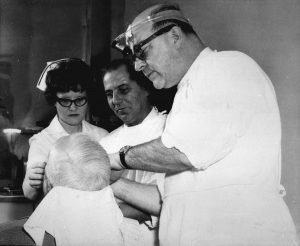
Dating back to the early years of the UW–Madison Department of Surgery, faculty and staff have made ground-breaking innovations in the field of surgery. One important innovation was Mohs Surgery, a micrographic surgery technique to remove skin cancer. Prior to Mohs Surgery, skin cancer was treated by making a wide surgical excision, which often resulted in significant deformity. The creation of Mohs Surgery led to a tedious but innovative approach to skin cancer that changed the future of skin cancer treatments.
Mohs Surgery was developed by Dr. Frederic Mohs, a faculty member in the Division of General Surgery from 1944-1983. Dr. Mohs began developing this technique while he was a medical student at UW–Madison. After medical school, he completed an internship in Portland, Oregon, and then returned to UW–Madison, where he joined the Department of Surgery.
Originally, Mohs’ technique involved using a zinc chloride chemical paste to destroy cancerous tissue layer by layer. Dr. Mohs would then use a microscope to examine the remaining tissue for malignant projections. The original iteration of this approach often required patients to have multiple visits in order to be treated.
Despite this, Mohs Surgery proved to be an effective way to treat skin cancer. In 1941, Dr. Mohs published his results for removing basal cell carcinomas in 440 patients, and his cure rate was 99%. Throughout the years, Dr. Mohs continued to modify his approach, and now, most patients can be treated with one visit.

After 60 years in the Department of Surgery, the Mohs Surgery technique was moved to the Department of Dermatology when it was formed in the early 2000s. Even though it is no longer a part of the Department of Surgery, Mohs Surgery marks a major contribution to the field of surgery and medicine as a whole.